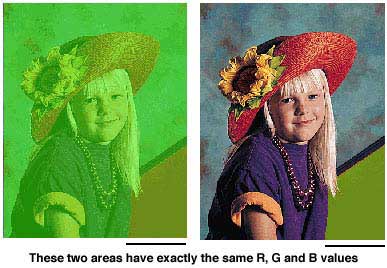Ask any A level physicist why we see the colours that we do and they should have no problem with the answer. They will tell you that it's due to the wavelength of the light that reaches our eyes (colour blindness notwithstanding).
As the wavelength of the light is lengthened from the invisible ultraviolet, it becomes blue. Further lengthening the wavelength takes us through the rainbow of colours until we arrive at red and then go into the invisible infrared.
This all seems pretty reasonable, until you look at the picture below. It appears that the same image has been duplicated but the left hand copy has a green wash over it.

Look at the bottom right hand corner of each image and decide what colour the background is. Stop reading until you have decided on the colours.
Ready? Read on. Look again at that bottom right hand corner of each image. Of course, there is a trick, but would you believe me if I said they were exactly the same colour? Try covering up the rest of the images. (If you're still not convinced and have a colour printer, print it out and fold the paper so that the two regions overlap.)
These two regions are exactly the same colour and exactly the same wavelength of light is reaching your eye from each of them. So why do you see different colours?
Between the light entering your eye and your conscious perception of the colour, a bit of interpretation has been added by your visual system!
When you look at a view dominated by hues of a single strong colour, your eyes and brain collaborate to try and differentiate what the colours would be like if the single colour were not washed over the image. This is an example of colour constancy and it has been suggested that it has evolved to help with colour vision (and hence the ability to spot prey or predator) in the orange-red glow of sunset or sunrise.
When we experience the world through our senses, we usually think that we are experiencing it "first hand" and untainted. Colour constancy and other examples show us that we actually appreciate the world in the way that makes most sense under the circumstances and that our consciousness is literally and metaphorically coloured by our own brains. Watch out - what you see is not necessarily what you get.










Comments
Add a comment